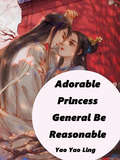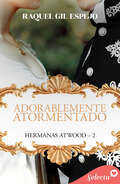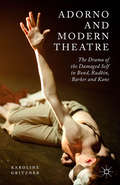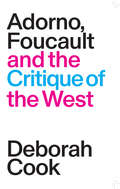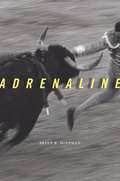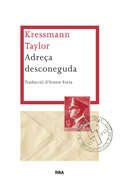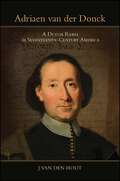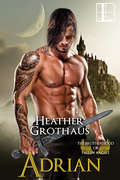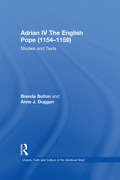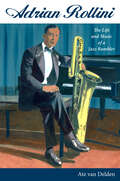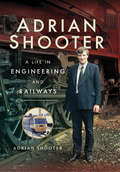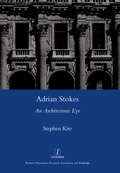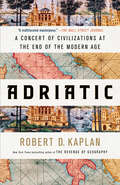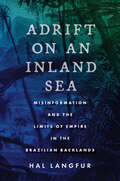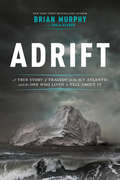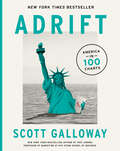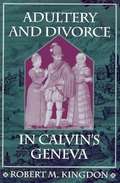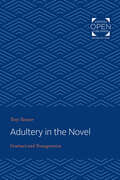- Table View
- List View
Adorable Princess: Volume 2 (Volume 2 #2)
by Yao YaoLingIt was well-known that Mo Mansion's direct daughter, Mo Ran, was arrogant and unreasonable.Once she transmigrated, she became the Mo Estate's direct daughter.With the virtue of my heart, I saved a man who was seriously injured, but I was caught by him.He couldn't chase them away, and he couldn't beat them either. He had to prevent them from being found out at all times.After leaving the capital for five years, Mo Yeyue, who had returned to the capital, discovered that not only did Mo Yanxue not turn crooked after not seeing him for a few years, he had become even more exquisite and more lively.With the virtue of being like a fertile river that didn't flow to a foreign land, Mo Yanxue decided to accept this little monster. It was enough to harm him by himself.
Adorable Princess: Volume 3 (Volume 3 #3)
by Yao YaoLingIt was well-known that Mo Mansion's direct daughter, Mo Ran, was arrogant and unreasonable.Once she transmigrated, she became the Mo Estate's direct daughter.With the virtue of my heart, I saved a man who was seriously injured, but I was caught by him.He couldn't chase them away, and he couldn't beat them either. He had to prevent them from being found out at all times.After leaving the capital for five years, Mo Yeyue, who had returned to the capital, discovered that not only did Mo Yanxue not turn crooked after not seeing him for a few years, he had become even more exquisite and more lively.With the virtue of being like a fertile river that didn't flow to a foreign land, Mo Yanxue decided to accept this little monster. It was enough to harm him by himself.
Adorable Princess: Volume 4 (Volume 4 #4)
by Yao YaoLingIt was well-known that Mo Mansion's direct daughter, Mo Ran, was arrogant and unreasonable.Once she transmigrated, she became the Mo Estate's direct daughter.With the virtue of my heart, I saved a man who was seriously injured, but I was caught by him.He couldn't chase them away, and he couldn't beat them either. He had to prevent them from being found out at all times.After leaving the capital for five years, Mo Yeyue, who had returned to the capital, discovered that not only did Mo Yanxue not turn crooked after not seeing him for a few years, he had become even more exquisite and more lively.With the virtue of being like a fertile river that didn't flow to a foreign land, Mo Yanxue decided to accept this little monster. It was enough to harm him by himself.
Adorablemente atormentado (Hermanas Atwood #Volumen 2)
by Raquel Gil EspejoLondres, 1871. Sus almas estaban atormentadas, sus cuerpos pedían a gritos amar y ser amados. Alice es la mayor de las hermanas Atwood. Han pasado tres años desde que Alice fuera presentada en sociedad, desde que se encaprichara de un noble y desde que este mancillara su honor, tomándola a la fuerza. Desde ese día, Alice no está interesada en el amor, no desea tener un marido. Su alegría, esa que siempre irradió, poco a poco se ha ido ensombreciendo. Anthony McLaine, marqués de Dumfries, había sido un crápula. Él y Thomas, el duque de Riderland, se conocieron en la Universidad de Eton y, desde el primer día, se hicieron inseparables. Habían compartido correrías nocturnas e incluso alguna que otra mujer. Sin embargo, nada queda en Anthony de aquel hombre despreocupado y libertino que un día fue. La muerte de su hermano y el hecho de figurar como la cabeza visible de su familia, que se desmorona a pasos agigantados, lo han sumido en una lacerante amargura que lo mantiene prisionero. Al igual que Bella y Thomas, Alice y Anthony también se conocieron en el baile del duque de Wakefield, un año atrás. Ambos afirmaron no estar interesados en encontrar pareja si no era para compartir un simple baile. La postura de Alice no ha cambiado. Su interés en conocer a un hombre con el que poder plantearse una vida en común continúa siendo nulo. Anthony, quien ha pasado de comerse el mundo a ser devorado por él, tampoco está interesado en el amor. Un inesperado viaje a Escocia, orquestado por Bella, hará que sus caminos se vuelvan a cruzar. ¿Encontrará Alice una razón para romper con su pasado, vivir su presente con esperanza y poder mirar al futuro con optimismo? ¿Será Anthony capaz de aceptar quién es, de irse desprendiendo de ese tormento que lacera su alma y de abrir las puertas de su corazón? ¿Podrán soñar, el uno de la mano del otro, con un mañana en el que no haya cabida para la soledad?
Adorno and Existence
by Peter E. GordonAdorno was forever returning to the philosophies of bourgeois interiority, seeking the paradoxical relation between their manifest failure and their hidden promise. As Peter E. Gordon shows, Adorno's writings on Kierkegaard, Husserl, and Heidegger present us with a photographic negative--a philosophical portrait of the author himself.
Adorno and Modern Theatre: The Drama of the Damaged Self in Bond, Rudkin, Barker and Kane
by K. GritznerAdorno and Modern Theatre explores the drama of Edward Bond, David Rudkin, Howard Barker and Sarah Kane in the context of the work of leading philosopher Theodor W. Adorno (1903-1969). The book engages with key principles of Adorno's aesthetic theory and cultural critique and examines their influence on a generation of seminal post-war dramatists.
Adorno's Practical Philosophy
by Fabian FreyenhagenAdorno notoriously asserted that there is no 'right' life in our current social world. This assertion has contributed to the widespread perception that his philosophy has no practical import or coherent ethics, and he is often accused of being too negative. Fabian Freyenhagen reconstructs and defends Adorno's practical philosophy in response to these charges. He argues that Adorno's deep pessimism about the contemporary social world is coupled with a strong optimism about human potential, and that this optimism explains his negative views about the social world, and his demand that we resist and change it. He shows that Adorno holds a substantive ethics, albeit one that is minimalist and based on a pluralist conception of the bad - a guide for living less wrongly. His incisive study does much to advance our understanding of Adorno, and is also an important intervention into current debates in moral philosophy.
Adorno, Foucault and the Critique of the West
by Deborah CookThe alliance of critical theory between Frankfurt and ParisAdorno, Foucault and the Critique of the West argues that critical theory continues to offer valuable resources for critique and contestation during this turbulent period. To assess these resources, it examines the work of two of the twentieth century's more prominent social theorists: Theodor W. Adorno and Michel Foucault. Although Adorno was situated squarely in the Marxist tradition that Foucault would occasionally challenge, Deborah Cook demonstrates that their critiques of our current predicament are complementary in important respects. Among other things, these critiques converge in their focus on the historical conditions-economic in Adorno and political in Foucault-that gave rise to the racist and authoritarian tendencies that continue to blight the West. Cook also shows that, when Adorno and Foucault plumb the economic and political forces that have shaped our identities, they offer remarkably similar answers to the perennial question: What is to be done?
Adrenaline
by Brian B. HoffmanFamous as the catalyst of the fight or flight response, adrenaline has also received forensic attention as a perfect, untraceable poison-and rumors persist of its power to revive the dead. True to the spirit of its topic, Adrenaline is a stimulating journey that reveals the truth behind adrenaline’s scientific importance and popular appeal.
Adreça desconeguda
by Kressmann TaylorUna història escrita sense complaença ni demagògia que descriu la tragèdia íntima i col·lectiva de l’Alemanya nazi. 1932 L’alemany Martin Schulse i el jueu nord-americà Max Eisnestein s’estimen com a germans i han obert plegats una galeria d’art a Califòrnia. Però Martin decideix tornar a casa, de manera que Max es queda sol per ocupar-se del negoci. Es cartegen amb freqüència des del primer dia, però quan Hitler accedeix al poder el 1933 la complicitat de la primera correspondència va derivant cap a l’horror. Adreça desconeguda va publicar-se per primera vegada el 1938, i en poc temps va ser considerada una obra mestra. Visionària, incisiva, i de desenllaç imprevisible, aquest llibre va ser tot un esdeveniment literari, el senyal d’alarma més estremidor contra el nazisme. Ressenyes:«Una història absolutament perfecta.»The New York Times «Una lliçó de literatura.»El País
Adriaen van der Donck: A Dutch Rebel in Seventeenth-Century America (Excelsior Editions)
by J. van den HoutThis book tells the compelling story of the young legal activist Adriaen van der Donck (1618–1655), whose fight to secure the struggling Dutch colony of New Netherland made him a controversial but pivotal figure in early America. At best, he has been labeled a hero, a visionary, and a spokesman of the people. At worst, he has been branded arrogant and selfish, thinking only of his own ambitions. The wide range of opinions about him testifies to the fact that, more than three centuries after his death, Van der Donck remains an intriguing character.J. van den Hout follows Van der Donck from his war-torn seventeenth-century childhood and privileged university education to the New World, as he attempted to make his mark on the fledgling fur trading settlement. When he became embroiled in the politics of Manhattan, he took the colonists' complaints against their Dutch West India Company administrators to the highest level of government in the Dutch Republic, in what became a fight for his adopted homeland and a bicontinental showdown. Denounced and detained, but not deterred, Van der Donck wrote a landmark book that stands as a testament to his vision for the country, as the changes he set in motion continued long after his early death and his influence became firmly embedded in the American landscape. Van der Donck's determination to stand by his convictions offers a revealing look into the human spirit and the strong will that drives it against adversity and in search of justice.
Adrian (Brotherhood of Fallen Angels #2)
by Heather GrothausIn the medieval Holy Land, four brave Crusaders fight tyranny and betrayal. They are the Brotherhood of Fallen Angels--and one by one, they may discover that love is the greatest adventure of all... From palaces and cathedrals to fortresses, Adrian Hailsworth's engineering genius is evident across the land--including the castle of Chastellet. But a bloody siege has left the stronghold, and Adrian, in ruins. Now a wanted man, he is forced into hiding at The Brotherhood of Fallen Angels Abbey, his brilliant mind plagued with nightmares, his spirit broken--until Father Victor presents him with a fiery redhead in need of help only Adrian can give... Maisie Lindsay is the lady-in-waiting to the Queen of Wyldonna, a small kingdom off the Scottish coast that is being blackmailed--by none other than the Brotherhood's most treacherous enemy. The only chance of saving Wyldonna lies in unearthing its vast fortune, hidden within a labyrinth of deadly traps and secret passages. The challenge enlivens Adrian--as does the passion Maisie ignites. But she is far more than she appears, and the truth may force Adrian to sacrifice his heart's longing to save her, before it's too late for them all...
Adrian IV The English Pope: Studies and Texts (Church, Faith and Culture in the Medieval West)
by Anne J. Duggan Brenda BoltonThe year 2000 witnessed the 900th anniversary of the birth of Adrian IV, the only Englishman to sit on the papal throne. His short pontificate of four and a half years, distracted by crisis and controversy and followed as it was by an 18-year schism, could be judged a low point in the history of the papacy. The studies in this book challenge the view that Adrian was little more than a cipher, the tool of powerful factions in the Curia. This is the first large-scale work on Adrian since 1925, and is supported by a substantial appendix of relevant sources and documents in facing translation. Relations with the Empire, the Norman kingdom and the Patrimony are all radically reassessed and the authenticity of 'Laudabiliter' reconsidered. At the same time, the spiritual, educational and devotional contexts in which he was operating are fully assessed; his activities in Catalonia and his legatine mission to Scandinavia are examined in the light of recent research, and his special relationship with St Albans is explored through his privileges to this great abbey. These studies by leading scholars in the field, together with the introductory chapter by Christopher Brooke, reveal an active and engaged pope, reacting creatively to the challenges and crises of the Church and the world.
Adrian Rollini: The Life and Music of a Jazz Rambler (American Made Music Series)
by Ate van Delden2020 Association for Recorded Sound Collections Awards for Excellence—Best History in the category of Best Historical Research in Recorded JazzAdrian Rollini (1903–1956), an American jazz multi-instrumentalist, played the bass saxophone, piano, vibraphone, and an array of other instruments. He even introduced some, such as the harmonica-like cuesnophone, called Goofus, never before wielded in jazz. Adrian Rollini: The Life and Music of a Jazz Rambler draws on oral history, countless vintage articles, and family archives to trace Rollini’s life, from his family’s arrival in the US to his development and career as a musician and to his retirement and death. A child prodigy, Rollini was playing the piano in public at the age of five. At sixteen in New York he was recording pianola rolls when his peers recognized his talent and asked him to play xylophone and piano in a new band, the California Ramblers. When he decided to play a relatively new instrument, the bass saxophone, the Ramblers made their mark on jazz forever. Rollini became the man who gave this instrument its place. Yet he did not limit himself to playing bass parts—he became the California Ramblers’ major soloist and created the studio and public sound of the band. In 1927 Rollini led a new band that included such jazz greats as Bix Beiderbecke and Frank Trumbauer. During the Depression years, he was back in New York playing with several bands including his own New California Ramblers. In the 1940s, Rollini purchased a property on Key Largo. He rarely performed again for the public but hosted rollicking jam sessions at his fishing lodge with some of the best nationally known and local players. After a car wreck and an unfortunate hospitalization, Rollini passed away at age fifty-three.
Adrian Shooter: A Life in Engineering and Railways
by Adrian ShooterThis book is the tale of a small boy from Surrey who had a fascination with anything on wheels and, also, loved to learn about people and what motivated them. He read a lot about railways and was excited by the innovations of our nineteenth-century predecessors. When the Beeching report came out in 1963, he decided that he wanted to be a part of the new order and help bring back some of that excitement. He describes his upbringing and paints a picture of the 'greyness' of the 1950s and then takes the reader on a voyage of discovery into the world of 1960's engineering before he joined British Railway in 1970.The view from the inside presents readers with a whole new picture of what was really going on within British Rail at various levels. Much that is reported has never before been published and the reasons for many decisions on previously opaque matters are explained.The author was cautioned by his school careers master to be wary of saying what he really thought. It seems that this piece of advice has not been heeded.
Adrian Stokes: An Architectonic Eye
by Stephen Kite"Adrian Stokes (1902-72) - aesthete, critic, painter and poet - is among the most original and creative writers on art of the twentieth century. He was the author of over twenty critical books and numerous papers: for example, the remarkable series of books published in the 1930s; The Quattro Cento (1932), Stones of Rimini (1934), and Colour and Form (1937) that embraced Mediterranean culture and modernity. His criticism extends the evocative English aesthetic tradition of Walter Pater and John Ruskin into the present, endowed by a stern sensibility to the consolations offered by art and architecture, and the insights that psychoanalysis affords. Indeed, for Stokes architecture provides the entree into art, and this book is the first study to comprehensively examine Stokess theory of art from a specifically architectonic perspective. The volume explores the crucial experiences through which this architectonic awareness evolved; traces the influence upon Stokes of places, texts and personalities, and examines how his theory of art developed and matured. The argument is supported by appropriate illustrations to confirm the evidence that Stokess claim for architecture as mother of the arts carries the deepest experiential and psychological import."
Adriatic: A Concert of Civilizations at the End of the Modern Age
by Robert D. Kaplan&“[An] elegantly layered exploration of Europe&’s past and future . . . a multifaceted masterpiece.&”—The Wall Street Journal&“A lovely, personal journey around the Adriatic, in which Robert Kaplan revisits places and peoples he first encountered decades ago.&”—Peter Frankopan, author of The Silk RoadsIn this insightful travelogue, Robert D. Kaplan, geopolitical expert and bestselling author of Balkan Ghosts and The Revenge of Geography, turns his perceptive eye to a region that for centuries has been a meeting point of cultures, trade, and ideas. He undertakes a journey around the Adriatic Sea, through Italy, Slovenia, Croatia, Montenegro, Albania, and Greece, to reveal that far more is happening in the region than most news stories let on. Often overlooked, the Adriatic is in fact at the center of the most significant challenges of our time, including the rise of populist politics, the refugee crisis, and battles over the control of energy resources. And it is once again becoming a global trading hub that will determine Europe&’s relationship with the rest of the world as China and Russia compete for dominance in its ports. Kaplan explores how the region has changed over his three decades of observing it as a journalist. He finds that to understand both the historical and contemporary Adriatic is to gain a window on the future of Europe as a whole, and he unearths a stark truth: The era of populism is an epiphenomenon—a symptom of the age of nationalism coming to an end. Instead, the continent is returning to alignments of the early modern era as distinctions between East and West meet and break down within the Adriatic countries and ultimately throughout Europe. With a brilliant cross-pollination of history, literature, art, architecture, and current events, in Adriatic, Kaplan demonstrates that this unique region that exists at the intersection of civilizations holds revelatory truths for the future of global affairs.
Adrift on an Inland Sea: Misinformation and the Limits of Empire in the Brazilian Backlands
by Hal LangfurFrom 1750 until Brazil won its independence in 1822, the Portuguese crown sought to extend imperial control over the colony's immense, sea-like interior and exploit its gold and diamond deposits using enslaved labor. Carrying orders from Lisbon into the Brazilian backlands, elite vassals, soldiers, and scientific experts charged with exploring multiple frontier zones and establishing royal authority conducted themselves in ways that proved difficult for the crown to regulate. The overland expeditions they mounted in turn encountered actors operating beyond the state's purview: seminomadic Native peoples, runaway slaves, itinerant poor, and those deemed criminals, who eluded, defied, and reshaped imperial ambitions. This book measures Portugal's transatlantic projection of power against a particular obstacle: imperial information-gathering, which produced a confusion of rumors, distortions, claims, conflicting reports, and disputed facts. Drawing on interdisciplinary scholarship in the fields of ethnohistory, slavery and diaspora studies, and legal and literary history, Hal Langfur considers how misinformation destabilized European sovereignty in the Americas, making a major contribution to histories of empire, frontiers and borderlands, knowledge production, and scientific exploration in the eighteenth and nineteenth centuries.
Adrift: A True Story of Tragedy on the Icy Atlantic and the One Who Lived to Tell about It
by Brian Murphy Toula VlahouA story of tragedy at sea where every desperate act meant life or deathThe small ship making the Liverpool-to-New York trip in the early months of 1856 carried mail, crates of dry goods, and more than one hundred passengers, mostly Irish emigrants. Suddenly an iceberg tore the ship asunder and five lifeboats were lowered. As four lifeboats drifted into the fog and icy water, never to be heard from again, the last boat wrenched away from the sinking ship with a few blankets, some water and biscuits, and thirteen souls. Only one would survive. This is his story.As they started their nine days adrift more than four hundred miles off Newfoundland, the castaways--an Irish couple and their two boys, an English woman and her daughter, newlyweds from Ireland, and several crewmen, including Thomas W. Nye from Fairhaven, Massachusetts--began fighting over food and water. One by one, though, day by day, they died. Some from exposure, others from madness and panic. In the end, only Nye and the ship's log survived.Using Nye's firsthand descriptions and later newspaper accounts, ship's logs, assorted diaries, and family archives, Brian Murphy chronicles the horrific nine days that thirteen people suffered adrift on the cold gray Atlantic. Adrift brings readers to the edge of human limits, where every frantic decision and desperate act is a potential life saver or life taker.
Adrift: America in 100 Charts
by Scott GallowayFrom bestselling author, CNN+ host of No Mercy, No Malice, and NYU business school professor Scott Galloway comes an urgent examination of the future of our nation – and how we got here. <p><p>We are only just beginning to reckon with our post-pandemic future. As political extremism intensifies, the great resignation affects businesses everywhere, and supply chain issues crush bottom lines, we’re faced with daunting questions: Is our democracy under threat? How will Big Tech change our lives? What does job security look like for me? America is on the brink of massive change—change that will disrupt the workings of our economy and drastically impact the financial backbone of our nation: the middle class. <p><p>In Adrift, Galloway looks to the past —from 1945 to present day—to explain just how America arrived at this precipice. Telling the story of our nation through 100 charts, Galloway demonstrates how crises such as Jim Crow, World War II, and the Stock Market Crash of 2008, as well as the escalating power of technology, an entrenched white patriarchy, and the socio-economic effects of the pandemic, created today’s perfect storm. Adrift attempts to make sense of it all, and offers Galloway’s unique take on where we’re headed and who we’ll become, touching on topics as wide-ranging as online dating to minimum wage to the American dream. Just as in 1945 and 1980, America is once again a nation at a crossroads. This time, what will it take for our nation to keep up with the fast and violent changes to our new world? <p> <b>New York Times Bestseller</b>
Adulescentia: The eclogues of Mantuan (Routledge Revivals)
by Lee PiephoFirst published in 1989, Piepho has translated the Latin works of Mantuan’s eclogues, which play such a crucial role in the culture of Western Europe during the sixteenth and seventeenth centuries.
Adult Continuing Education and High School Course Catalog
by Hadley Institute for the Blind Visually ImpairedAdult Continuing Education and High School Course Catalog 2016-2017. Catalog of current distance education courses for the blind or visually impaired. Various media for the courses is available including; Braille, CD, Digital Talking Books, Large Print, Online and more. Not all courses are available in all formats.
Adultery and Divorce in Calvin’s Geneva (Harvard Historical Studies #118)
by Robert M. Kingdon<p>In Calvin's Geneva, the changes associated with the Reformation were particularly abrupt and far-reaching, in large part owing to John Calvin himself. Adultery and Divorce in Calvin's Geneva makes two major contributions to our understanding of this time. The first is to the history of divorce. The second is in illustrating the operations of the Consistory of Geneva--an institution designed to control in all its variety the behavior of the entire population--which was established at Calvin's insistence in 1541. This mandate came shortly after the city officially adopted Protestantism in 1536, a time when divorce became legally possible for the first time in centuries. <p>Robert Kingdon illustrates the changes that accompanied the earliest Calvinist divorces by examining in depth a few of the most dramatic cases and showing how divorce affected real individuals. He considers first, and in the most detail, divorce for adultery, the best-known grounds for divorce and the best documented. He also covers the only other generally accepted grounds for these early divorces--desertion. <p>The second contribution of the book, to show the work of the Consistory of Geneva, is a first step toward a fuller study of the institution. Kingdon has supervised the first accurate and complete transcription of the twenty-one volumes of registers of the Consistory and has made the first extended use of these materials, as well as other documents that have never before been so fully utilized.</p>
Adultery in the Novel: Contract and Transgression
by Tony TannerOriginally published in 1979. Adultery is a dominant feature in chivalric literature; it becomes a major concern in Shakespeare's last plays; and it forms the central plot of novels from Anna Karenina to Couples. Tony Tanner proposes that transgressions of the marriage contract take on a special significance in the "bourgeois novels" of the eighteenth and nineteenth centuries. His interpretation begins with the general topic of adultery in literature and then zeroes in on three works—Rousseau's La Nouvelle Héloïse, Goethe's Die Wahlverwandtschaften, and Flaubert's Madame Bovary. His interpretation encompasses the role of women, the structure of the family, social mores, and the history of sexuality.
Adultery: Infidelity and the Law
by Deborah L. RhodeDespite declining prohibitions on sexual relationships, Americans are nearly unanimous in condemning marital infidelity. Deborah Rhode explores why. She exposes the harms that criminalizing adultery inflicts--including civil lawsuits, job termination, and loss of child custody--and makes a case for repealing laws against adultery and polygamy.
